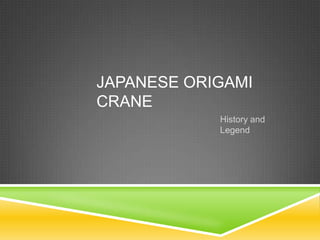
Japanese origami cranes
- 1. JAPANESE ORIGAMI CRANE History and Legend
- 2. The Japanese word “origami” is a compound of two smaller Japanese words: “ori”, meaning to fold, and “kami”, meaning paper. Japanese origami began sometime after Buddhist monks carried paper to Japan during the 6th century. The first Japanese origami is dated from that time period and was used for religious ceremonial purposes only, due to the high price of paper.
- 3. In 1797 the first known origami book was published in Japan: Senbazuru Orikata. There are several stories in Japanese culture, such as the story of Abe no Seimei making a paper bird and turning it into a real one. One of the most famous origami designs is the Japanese Crane. The crane is lucky in Japanese culture.
- 4. Legend says that anyone who folds 1000 paper cranes will have their heart‟s desire come true. The origami crane has become a symbol of peace because of this belief and because of a young Japanese girl named Sadako Sasaki. Sadako was exposed to the radiation of the atomic bombing of Hiroshima as an infant, and it took its inevitable toll on her health. She was a hibakusha – an atomic bomb survivor. By the time she was 12, in 1955, she was dying of leukemia.
- 5. Hearing the legend of the Japanese crane, Sadako decided to fold 1,000 origami cranes so that she could live. When she saw that the other children in her ward were dying, she realized that she would no survive and wished instead for world peace and an end to suffering. A popular version of the tale is that Sadako folded 644 cranes before she died; her classmates then continued folding cranes in honor of their friend. She was buried with a wreath of 1,000 cranes to honor her dream. While her effort could not extend her life, it moved her friends to make a granite statue of Sadako in the Hiroshima Peace Park: a girl standing with her hands outstretched, a paper crane flying from her fingertips.
- 6. Every year the statue of Sadako is adorned with thousands of wreaths made with 1,000 origami cranes. A group of 1,000 paper cranes is called senbazuru in Japanese. The tale of Sadako has been dramatized in many books and movies. In one version, Sadako wrote a haiku that translates into English as: „I shall write peace upon your wings, and you shall fly around the world so that children will no longer have to die this way.
